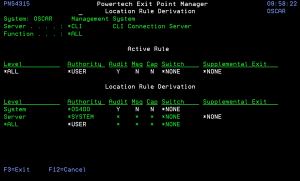How to Get There
On the Work with Security by Location panel, choose 5 for a Location Rule.
What it Does
The Powertech Location Rule Derivation panel displays the hierarchical inheritance of the current Location rule.
Options
System
System indicates the target of any operations you perform. When you add rules, for example, those rules will be sent to, and will affect processing on, the System named.
Server
The server to which the current rule applies.
Function
The name of the IBM server function to which the current rule applies.
Level
The Level column indicates from which inheritance level the specific values listed are derived.
The last entry in the Rule Derivation section is the level from which the Location Rule Display was requested. For example, if this display were requested from "Work with Authorities by Location", the last level would represent a location.
Valid values are:
Authority
The authority assigned to the user for this rule.
Switch
The Switch profile holds the name of a user profile whose authority is used to process the transaction instead of the authority of the User initiating the transaction. The transaction is executed as, and uses the authority of, this Switch profile.
The job that processes the transaction continues to run under this switch profile until Exit Point Manager processes another transaction request for that job.
Switch profile is allowed only when Authority contains *SWITCH or *MEMSWITCH, if *MEMSWITCH is allowed. Otherwise it must contain *NONE.
Audit
The audit property controls the type of requests Exit Point Manager will log.
Possible values are:
Msg
The message property entry will determine if Exit Point Manager sends a message to the specified message queue for the user/server/function. Possible values are:
Cap
Capture transactions for Memorized Transaction Request (MTR).
Possible values are:
Command Keys
F3 (Exit): Exit the program without processing any pending changes.
F5 (Refresh): Refreshes the screen and resets all available text fields.
F12 (Cancel): Exit the screen without processing any pending changes.
